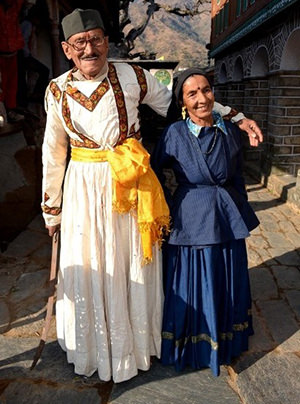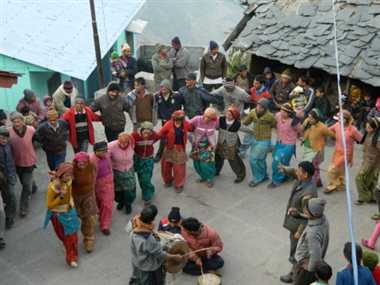The culture, rituals and beliefs of Jaunsari tribe is often linked with occult and mysticism as the region is underdeveloped which makes it relatively unexplored than other counterparts.
Jaunsar-Bawar is a mountainous region which is located about 85 km from Mussoorie at Chakrata tehsil in Dehradun district. The area is inhabited by Jaunsari tribe which dates back to the period of Pandavas of the famous mythological tale Mahabharata. Jaunsar-Bawar comprises of two regions namely Jaunsar which is the lower half and Bawar which is the upper snow clad region which includes ‘Kharmba Peak’ situated about 10,118 ft above sea level.
The Jaunsar-Bawar region doesn’t share any different attributes as both of them are geographically adjacent to each other. Bawar is a predominant tribal community which resides in the upper regions of the area, having no social contact with the outside world. Bawar has still managed to withhold their culture and traditions which have lured many famous historians and anthropologists for conducting research work in this region.
The Britishers conquered Jaunsar along with Dehradun after the war of 1814 with the Gurkhas. Later in 1829, it was incorporated in Chakrata tehsil. During post-Independence period, Jaunsar was a part of Punjab state of Sirmur. Before the establishment of British Indian Army cantonment in 1866, the entire area was known as Jaunsar-Bawar.
Jaunsaris trace their ethnic origin from Pandavas of the mythological tale ‘Mahabharata’ who married ‘Draupadi’ also known as ‘Panchali’ as she was the only wife of the five Pandava brothers. Since then the practice of polygamy and polyandry has been prevailing in Jaunsar-Bawar. Jaunsaris claim to be descendants of the Pandavas while the Bawaris are from the Kauravas or Duryodhana’s clan.

A woman with her five husbands. (Culture of Polyandry). Photo source: freelyshout.com
In Jaunsar the practice of polygamy and polyandry was prevalent. The richer tribesmen practiced polygamy while the poor counterparts practiced polyandry which can also be called as ‘Fraternal Polyandry’ in which two or more brothers choose to share a wife. Though, anthropology studies done in the 1990s states that these practices were fast phasing out which were further replaced by monogamy. Whereas, recent studies have found that such practices do not exist at present.

An old couple in Jaunsari traditional attire. Photo source: cargocollective.com
Another unique custom followed by Jaunsaris is the concept of bride price. The custom is based on the logic that parents spend a significant amount on raising, educating and nurturing their daughter. Which in turn is an asset to the family as she does all the household work, takes care of the family and works in the farmland. If a man desires to marry her, then he must pay a fair price for her as he is taking away an asset of the family. Another interesting attribute of Jaunsari culture is that divorce is not considered as a taboo and divorced women are not ostracized from society. However, if a woman decides to go back to her paternal home after a divorce then her family must return back the bride price to the man’s family. In case, if a woman divorces her husband to marry another man, the second man must pay a higher bride price to the first man’s family.

People are dancing during the festival of ‘Maroj’ in Jonsar-Bawar region. Photo source: jagran
Jaunsari community reveres to ‘Mahasu Devta’ which is one of the principal deities of Jaunsari tribes. Dance and music are also an integral part of the culture of Jaunsari community. During festivals both men and women dance to the rhythm of the melodious folk music. The dancers fashion themselves in colorful traditional clothes; representing the rich culture of Jaunsar while the local people wear ‘Thalka’ or ‘Lohiya’, which is a long coat. The local people perform folk dances like Barada Nati, Harul and Raso on festive occasions like ‘Magh Mela’ and ‘Bissu’, a type of fair which marks the harvesting period. During Magh Mela villagers sacrifice ‘Maroj’ an ogre to their deity as according to a local legend it is believed that Maroj haunted in the valley for years.
But Sonu Negi, why every Garhwali person do selective marketing for word Garhwali. They do regional discrimination in office, society everywhere. That’s why outside Uttarakhand everyone know only Garhwal. Did you heard such regions in Himachal. No because they are proud to be Himachal but here they are proud to be Garhwali. Think about it. It sounds bad but is bitter truth of Garhwal.
i’m from uttrakhand ….we dont are not garwali or jaunsari …we all are 1 so called pahari ❤
The practice of ‘bride price’ was also prevalent in other areas of Garhwal in the older days. Today, this practice along with other older customary practices like polygamy, dhanti marriages etc. are no longer popular among the Garhwali people.
As time passes, the value systems and customs undergo changes. In Garhwal, the past century saw a rapid cultural transformation with mainstream practices of Uttar Pradesh gaining prestige and acceptance among the Garhwali people. Such customary practices of Garhwal were recorded by many scholars in the last century. Anecdotally speaking, I have heard of polygamy, dhanti marriages and bride price in Garhwali villages from my late grandfather who was born in a village in Pauri Garhwal in the early 1900’s.
Jaunsaries are unique tribal group, practicing caste hierarchy among them. They have been declared as scheduled Tribe in 1967 for being backward and living in the remote areas and practicing polyandry which is a unique system. However, Polyandry is common practice in himaalayan tribes from uttrakhand to Tibbet. As far as I know, Mussourie is 32 kms from Chakrata via Chakrata-Purodi road. So technically the Brahmins and Rajputs falls under the status of Scheduled tribes and artisan caste and Koltas who are at the lowest ladder of caste heirarchy falls under the status of scheduled caste. still in many areas they practice ‘untouchability’ in personal sphere but cannot do the same at public sphere because of government’s interventions and constitution’s basic rights. for this reason many people criticize the government (obviously from upper caste) as they still consider so called lower caste people as their servants/ bond laborer, who used to serve in their fields and houses.
I am a research scholar and working on their culture since last 8 years. writing blog is a good but one should be clear with facts. With regard to the bride price, it was a custom practiced earlier among themselves but it was not a huge amount. the major reason for the bride price were two: one, their helping hand was going to another place so of course it was a loss of her parents because women in tribal area are core to the economy. secondly, it was a kind of promise that the particular girl will marry in that house only. you can understand it as modern term ‘Roka’ which people do in northern plains. moreover, bride price was common among most of the tribal societies because women have to play major role in economy i.e. agriculture. Also, it is the women’s family who used to go at groom’s house for marriage and groom’s family was the host to organise marriage. But with coming in the contact of non-tribal people, these customs have extinct and now like all other places in India, barat system and dowry has started among them. There is lot about their culture but I am writing only that part which is needed for further clarifications regarding your blog.
Thank you!!!!
Keep Traveling , Keep Writing, Keep sharing!!!!!!
” Jaunsar-Bawar is a mountainous region which is located about 85 km from Mussoorie at Chakrata tehsil in Dehradun district.”
Please indicate direction also here.
Hello Pragati, I am a filmmaker. You have shared a valuable details about Jaunsari community, I just wanted to know, do people from Jaunsari go for studies or for works out of their regions. If the practice of ‘Polygamy’ and ‘Polyandry’ still prevails there. I am working on a story and your information will be helpful to me.
Beautifully explained
Very mystical tribal information.
In jaunsar (chauhan) uttrkhnd they r bhramend, pandit or not??
very interesting, useful and well written matter.